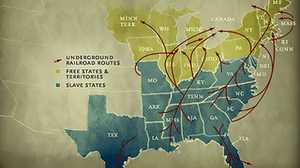Antebellum Women's Rights
Many women supporters of women's rights directed their political activism into the abolitionist movement. Speaking out publicly against injustice, publishing and editing newspapers, and helping slaves escape to freedom, these pioneers achieved successes unprecedented for women at the time.

Susan B. Anthony
Like many early reformers, Susan B. Anthony began her political career as a temperance crusader. But in 1851, after a fateful meeting with suffrage activist Elizabeth Cady Stanton, she threw herself into the women's rights and abolition causes. Anthony flourished in her relationship with the well-educated, politically astute Stanton, and the two made an indomitable team.
As an agent of the American Anti-Slavery Society, Anthony traveled relentlessly, speaking out in favor of freedom for African Americans. She also campaigned vigorously to extend women's rights. She worked with Stanton to gain passage of New York's Married Women's Property Law. Passed in 1860, the measure gave women legal control over their own wages, property, and children for the first time.
For the rest of her career, Anthony fought for civil rights for women and African Americans, serving as a leader of several national organizations, including the National Woman Suffrage Association. From 1868-70, she was a co-publisher with Stanton of the New York newspaper The Revolution. Later, she and Stanton co-published the four-volume The History of Woman Suffrage.
A fearless activist who understood the power of publicity, Anthony was arrested for voting in the 1872 presidential election. An all-male jury convicted her, but she refused to pay her fine. Anthony was honored internationally for her efforts on behalf of women. Still, by the time of her death in 1902, only four states in the United States allowed women to vote.
Elizabeth Cady Stanton
Elizabeth Cady Stanton experienced a critical moment in her development as a feminist at the 1840 World Anti-Slavery Convention in London. At the convention, which Stanton attended with her husband, abolitionist Henry Brewster Stanton, women were forbidden from officially participating. Lucretia Mott, another American woman at the convention, shared Stanton's disappointment at the prohibition. The two discussed the need for a convention on women's rights.
Eight years later, Mott and Stanton saw their idea come to fruition, at the world's first women's rights convention, held at Seneca Falls, New York. There, Stanton read the Declaration of Sentiments, a document modeled on the Declaration of Independence that outlined women's grievances and their demands for civil rights. Soon, one issue — womans suffrage — would occupy most of her time.
In 1851 Stanton met Susan B. Anthony, and the two formed a powerful partnership. Stanton, the mother of seven children, was limited in her ability to travel. Often working at home, she lent her considerable skills as a writer to the suffrage cause. Anthony organized strategy and front-line action.
Together with Anthony, Elizabeth Cady Stanton published The Revolution, a New York newspaper, and The History of Woman Suffrage, a four-volume story of the movement. In her later years Stanton traveled extensively, speaking out and writing voluminously on behalf of women's rights.
Sojourner Truth
Freed from slavery in 1827, Sojourner Truth became an eloquent speaker not only for abolition, but for women's rights as well. Born in bondage to the Hardenberghs, an affluent Dutch family in the late 1790s, Truth was originally named Isabella. Bell Hardenbergh, as she was commonly known, was visited at a young age by voices and visions that she believed were messages from God. After a farmer named Isaac Van Wagener helped Isabella gain her freedom, she adopted his last name as her own.
Isabella Van Wagener began her career as a preacher in New York City, carrying the message of God to anyone who would listen. In 1843 she joined a utopian community of abolitionists in Northampton, Massachusetts. At about that time, she adopted the name Sojourner Truth. Truth traveled throughout the East and Midwest preaching in churches, tent meetings, private homes, and village streets. At Northampton, she had adopted the cause of abolition; later she would speak out on behalf of women's rights as well.
Truth's autobiography, The Narrative of Sojourner Truth, helped reveal the cruelties of slavery and enjoyed brisk sales in the North. A version of her speech at the 1851 women's Rights Convention in Akron, Ohio, became a cornerstone of the women's movement. Known as the "Ain't I a Woman?" speech, this version is believed to be a rewriting of Truth's actual remarks.
During the Civil War, Truth worked on behalf of both African American soldiers and newly freed slaves. In 1864, she met with Abraham Lincoln in the White House. After the war Truth continued her efforts to find new homes for freedmen. She died in Battle Creek, Michigan, in 1883.







